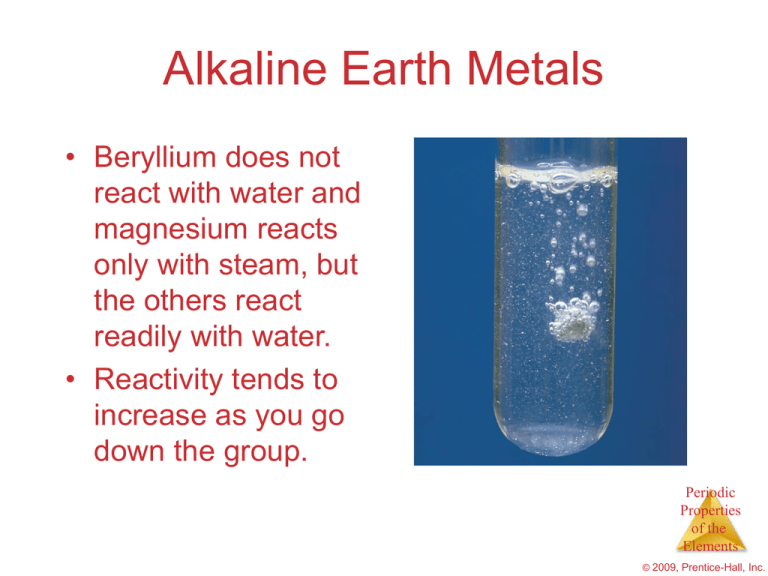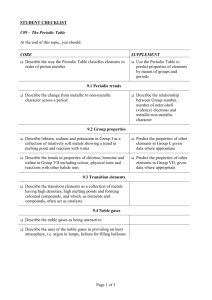Periodic Properties of Elements: Groups & Reactivity
advertisement

Alkaline Earth Metals • Beryllium does not react with water and magnesium reacts only with steam, but the others react readily with water. • Reactivity tends to increase as you go down the group. Periodic Properties of the Elements © 2009, Prentice-Hall, Inc. Group 6A • Oxygen, sulfur, and selenium are nonmetals. • Tellurium is a metalloid. • The radioactive polonium is a metal. Periodic Properties of the Elements © 2009, Prentice-Hall, Inc. Oxygen • There are two allotropes of oxygen: – O2 – O3, ozone • There can be three anions: – O2−, oxide – O22−, peroxide – O21−, superoxide • It tends to take electrons from other elements (oxidation). Periodic Properties of the Elements © 2009, Prentice-Hall, Inc. Sulfur • Sulfur is a weaker oxidizer than oxygen. • The most stable allotrope is S8, a ringed molecule. Periodic Properties of the Elements © 2009, Prentice-Hall, Inc. Group VIIA: Halogens • The halogens are prototypical nonmetals. • The name comes from the Greek words halos and gennao: “salt formers”. Periodic Properties of the Elements © 2009, Prentice-Hall, Inc. Group VIIA: Halogens • They have large, negative electron affinities. – Therefore, they tend to oxidize other elements easily. • They react directly with metals to form metal halides. • Chlorine is added to water supplies to serve as a disinfectant Periodic Properties of the Elements © 2009, Prentice-Hall, Inc. Group VIIIA: Noble Gases • The noble gases have astronomical ionization energies. • Their electron affinities are positive. – Therefore, they are relatively unreactive. • They are found as monatomic gases. Periodic Properties of the Elements © 2009, Prentice-Hall, Inc. Group VIIIA: Noble Gases • Xe forms three compounds: – XeF2 – XeF4 (at right) – XeF6 • Kr forms only one stable compound: – KrF2 • The unstable HArF was synthesized in 2000. Periodic Properties of the Elements © 2009, Prentice-Hall, Inc.

